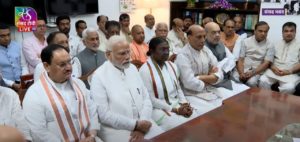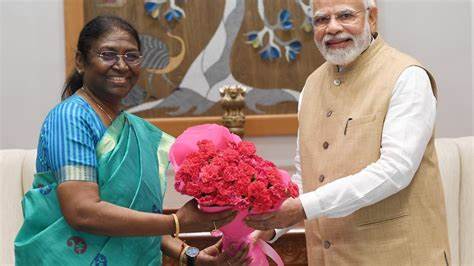If one believes in the simple mathematical calculation and minimum political honesty of public representatives in the Indian Parliament and State legislative assemblies, the largest democracy on Earth is expecting a lady tribal President in New Delhi next month. As Draupadi Murmu, a simple Janjati family woman turned a teacher turned a politician, gets the recommendation from the ruling Bharatiya Janata Party-led National Democratic Alliance government for the Presidential elections scheduled for 18 July next, her victory becomes almost imminent.
Hailing from Mayurbhanj locality of Odisha, who taught in Shri Aurobindo Integral Education Centre, the NDA’s Presidential candidate earlier served Jharkhand as its governor and her own State as a minister. After arriving in New Delhi, Murmu has filed her nomination papers in the presence of Prime Minister Narendra Modi, Union home minister Amit Shah, defense minister Rajnath Singh, BJP national president JP Nadda, UP chief minister Yogi Adityanath, MP CM Shivraj Singh Chouhan, Assam CM Himanta Biswa Sarma, etc. Her main opponent will be a seasoned politician, who had lately shifted his loyalty from the saffron party. Yashwant Sinha, a former Union minister, has been declared the joint opposition candidate for the Presidential polls.
The Election Commission of India had recently announced the schedule of Presidential elections as the five-year tenure of President Ram Nath Kovind comes to an end on 24 July 2022. The nominations (for 18 July polling) are accepted till 29 June and the poll result will be available on 21 July. For the record, any citizen of India can become the country’s President after fulfilling a few conditions. The aspirant must be at least 35 years old and he/she has the qualification to be elected as a member of the Lok Sabha. On submitting the nomination, the aspirant needs 50 recognized proposers and 50 seconders.

Unlike other democratic nations, the common Indians do not elect their president directly, but the Head of the Republic is voted by the people’s representatives (meaning the Parliamentarians and Legislators), with the basis of the Electoral College. It includes 543 members of Lok Sabha (the lower house of Parliament), 233 members in Rajya Sabha (the upper house) and 4,033 members of legislative assemblies across the vast country. The value of an MP’s vote in the Presidential elections varies with the total number of Legislators in State (including Union Territories) legislative assemblies. An MLA’s vote value depends on the number of electorates of the concerned State/UT.
The ruling BJP has 92 Rajya Sabha members (including four nominated MPs, who cannot vote) and 301 Lok Sabha MPs, which is more than the half of combined strength of both houses. The saffron party also enjoys support from its allies like Janata Dal-United, Rashtriya Lok Janshakti Party, Apna Dal, Asom Gana Parishad, Mizo National Front, National People’s Party, etc. As the BJP retains power in 18 States, it enjoys impressive numbers (along with the political allies) among Legislators too.
Meanwhile, in Murmu’s home State, the Biju Janata Dal government chief Naveen Patnaik urged all political parties of Odisha to support her (even though they are not NDA allies). Patnaik, who remains in power for over two decades, also appealed to the opposition parties to withdraw their candidate (Yashwant Sinha). Andhra Pradesh chief minister YS Jagan Mohan Reddy indicates his party YSRCP may support Murmu. Others who may join the league are comprised of TRS (Telangana), AAP (Delhi & Punjab), JMM (Jharkhand), AIADMK (Tamil Nadu), etc.
For the ruling BJP, there were a number of choices for the presidential polls, including the incumbent vice-President Venkaiah Naidu and a few reputed Governors of different States. But the party, which has been facing massive public uproars for the Nupur Sarma-Prophet Muhammad controversy, Agnibeer defense policy, price rise of essential commodities, etc silently picked up Murmu (a Santhal) to replace a Dalit in Rashtrapati Bhawan (Kovind is the second Dalit President of India after KR Narayanan).
The struggling life of Murmu can also impress anyone who looks through her days, from a poor tribal family to completing her studies at Bhubaneswar Ramadevi Women’s College against all odds. Born on 20 June 1958, Murmu started her career as a teacher before joining Odisha politics. She was elected to the State legislative assembly twice as a BJP member. Murmu served various portfolios as a minister of the State government in Bhubaneswar. Incidentally, she became the first woman Governor of Jharkhand (2015 to 2021).
Her first reaction to the development was a big surprise. ‘I am surprised, I was not able to believe it,’ said Murmu while speaking to journalists and added that she would work with the constitutional guidelines if elected to the coveted post. PM Modi in an initial tweet commented that Murmu has rich administrative experience and had an outstanding gubernatorial tenure. Meanwhile, the Akhil Bharatiya Vanvasi Kalyan Ashram (ABVKA), backed by BJP’s influential ideologue Rashtriya Swayamsevak Sangh, termed Murmu’s candidature as a historic moment for 120 million Janajati people of India.
“Janajatis are an integral constituent of tradition and inheritors of an esteemed culture of the great Indian nation. However they have been overlooked and disregarded for many centuries,” said Ramchandra Kharadi, president of ABVKA, which is identified as India’s largest tribal non-government welfare organization. He asserted that a historical decision has been taken to nominate a Santhali Janajati lady as the presidential candidate when the nation is celebrating the glorious 75th year of its independence.










